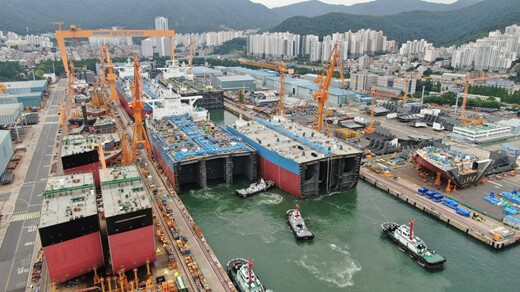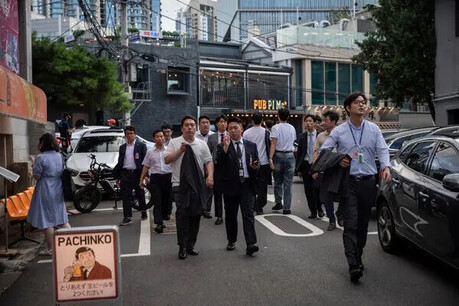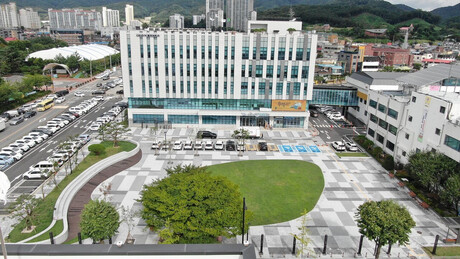
Busan, South Korea – In a bold move to spearhead the next generation of maritime transport, South Korea has officially launched a national initiative aimed at developing and commercializing the world's most advanced liquid hydrogen carriers. Recognizing the immense potential of hydrogen as a clean energy source, and leveraging its existing prowess in liquefied natural gas (LNG) vessel construction, the Ministry of Trade, Industry and Energy (MOTIE) inaugurated a public-private joint task force on May 9th in Busan, aptly dubbed the 'K-Shipbuilding Dream Team'.
The development of efficient and safe liquid hydrogen carriers is considered a pivotal step in the global transition towards a hydrogen-based economy. Liquefying hydrogen at an ultra-cryogenic temperature of -253 degrees Celsius dramatically reduces its volume by a factor of 800, offering a revolutionary improvement in transportation efficiency compared to gaseous hydrogen. This technological leap is crucial for enabling the large-scale international trade of hydrogen, a key component of many nations' decarbonization strategies.
Despite the significant global interest and ongoing research, the commercialization of large-scale liquid hydrogen carriers remains a formidable challenge. The extreme cryogenic temperatures required for storage and transport necessitate the development of sophisticated and robust containment systems, advanced materials capable of withstanding these conditions, and specialized handling equipment. As such, while several nations are actively pursuing this technology, a truly commercially viable, large-capacity liquid hydrogen carrier has yet to be deployed.
South Korea, already a global leader in shipbuilding, particularly in the construction of LNG carriers, sees liquid hydrogen transport as a natural and strategic progression. LNG carriers share some technological similarities with liquid hydrogen carriers, particularly in cryogenic handling and storage, giving Korean shipbuilders a potential head start. Furthermore, the high technological barrier to entry and the anticipated high value-added nature of these vessels align with South Korea's strategy of focusing on high-tech, high-growth industries.
The International Energy Agency (IEA) projects a substantial increase in the demand for liquid hydrogen carriers, estimating that approximately 200 such vessels will be needed by 2050 to meet the burgeoning global hydrogen market. This forecast is underpinned by the expectation that worldwide hydrogen production and utilization will reach 500 million tons annually by the mid-century, driven by commitments to net-zero emissions and the versatility of hydrogen as an energy carrier and industrial feedstock.
However, experts like Noh Gil-tae, a senior researcher at the Korean Register of Shipping (KR), caution that the widespread adoption of liquid hydrogen carriers for long-distance transport is likely a longer-term prospect, potentially materializing after 2030. The technology for ultra-cryogenic cargo tanks and associated equipment is still in the research and development phase. Moreover, the establishment of large-scale hydrogen liquefaction plants at production sites is a prerequisite for efficient liquid hydrogen transport, adding another layer of complexity to the deployment timeline.
Recognizing the immense future potential, major global players are actively engaged in the race to develop liquid hydrogen transport solutions. Japan's Kawasaki Heavy Industries (KHI) achieved a significant milestone with the construction of the Suiso Frontier, the world's first liquid hydrogen carrier, which has successfully transported liquefied hydrogen from Australia in a pilot project. This demonstration highlighted the technical feasibility of transoceanic liquid hydrogen transport, albeit on a smaller scale.
South Korea is determined not to be left behind in this critical technological race. MOTIE announced its "super-gap leading strategy" for liquid hydrogen carriers last year, signaling a firm commitment to becoming a frontrunner in this emerging market. The strategy outlined three key pillars: securing foundational technologies for core materials, components, and equipment; pursuing aggressive scaling and demonstration projects; and fostering a robust public-private collaborative ecosystem.
To translate this strategy into tangible progress, the South Korean government has pledged a substantial investment of 55.5 billion won (approximately $42 million USD) this year alone. A key objective of this funding is the construction of what is envisioned to be the world's largest liquid hydrogen demonstration vessel by 2027. This ambitious project aims to validate the scalability and operational viability of large-capacity liquid hydrogen transport.
The 'K-Shipbuilding Dream Team' assembled by MOTIE comprises a formidable array of domestic expertise, bringing together the technological prowess of South Korea's "Big Three" shipbuilders – Hyundai Heavy Industries, Samsung Heavy Industries, and Daewoo Shipbuilding & Marine Engineering 1 – alongside leading universities and research institutions. This concentration of knowledge and experience is intended to accelerate the pace of innovation and ensure a coordinated approach to the complex technological challenges involved.
MOTIE's role extends beyond funding and coordination. The ministry intends to actively cultivate a collaborative ecosystem by facilitating linkages and synergies between various research and development projects, fostering cooperation in the construction of demonstration vessels, and working towards the establishment of a reliable domestic supply chain for critical liquid hydrogen equipment and materials. Currently, a remarkable 43 research and development projects involving 101 different organizations are simultaneously underway in South Korea, underscoring the scale and intensity of the national effort. Effective governance and coordination will be crucial to ensure that these diverse initiatives are aligned and mutually reinforcing.
A representative from MOTIE emphasized the strategic importance of this undertaking, stating, "Liquid hydrogen carriers represent a high-stakes, high-reward area with significant initial technology development risks. The government's role is crucial in providing the initial impetus to secure new growth engines for K-shipbuilding. We are committed to actively supporting the refinement of relevant legal and regulatory frameworks and ensuring the early acquisition of large-scale liquid hydrogen carrier technology so that the solutions we develop can become the global standard."
South Korea's determined pursuit of liquid hydrogen carrier technology signifies a strategic bet on the future of clean energy and maritime transport. By mobilizing its shipbuilding expertise and fostering collaboration across industry, academia, and government, the nation aims to not only secure a dominant position in a potentially transformative market but also contribute significantly to the global transition towards a sustainable energy future. The success of the 'K-Shipbuilding Dream Team' could solidify South Korea's leadership in maritime innovation for decades to come.
[Copyright (c) Global Economic Times. All Rights Reserved.]





























